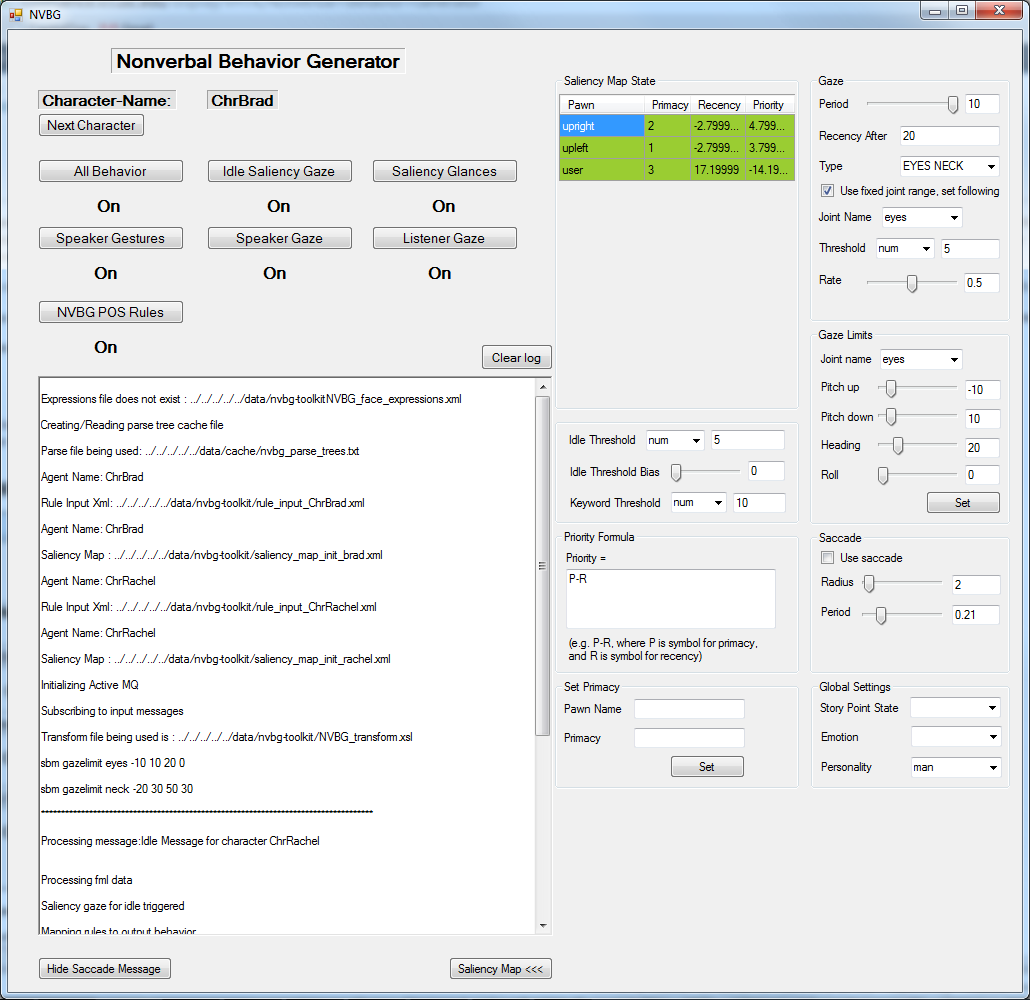Page History
...
- The NVBG is located at https://svn.ict.usc.edu/svn_vh/trunk/core/NVBG
- Main Developer: Shridhar Ravikumar
Snapshot of NVBG
Users
Currently the NVBG needs to be setup on a per character basis i.e. each character in the scene needs to have his/her own process of NVBGThe NVBG now supports multiple characters within one process. You can toggle between these characters as desired.The character itself needs to be configured using the various confuguration options that NVBG provides. You can do this using a config file or through VHMessages.
In order to configure NVBG for a particular character, you need to have/setup the following:
- The rule_input_[culture].xml (behavior) file, that specifies which rules should be generated for parts of speech in the spoken sentence and also which animations map to which words if any. Assuming you have the rule-input-[char-name].xml file you need to pass it as an argument to NVBG when you run the executable so that it knows which file to use for rules.
- The .xslt transform files which process the the intermediate The .xslt transform files which process the the intermediate xml generated by the module and generate the final bml to be output. The defaults are available at http://svn.ict.usc.edu/svn_vh/trunk/data/nvbg-common/. The relevant files are NVBG_transform.xsl, NVBG_rules.xsl and NVBG_behavior_description.xsl
- The command line parameters to NVBG including the character-name, character-culture, idle posture and some other optional parametersNVBG
- OPTIONAL - we can also specify a saliency map and a facial-expressions configuration if needed.
- The saliency map specifies which objects in the scene are of particular importance which allows NVBG to generate idle gazes appropriately.
- The facial-expressions configuration file allows us to specify which facs units should be triggered with a certain weight so that a facial expression is achieved. This facial expression can later be tagged in the input text as markup to trigger the facial expression.
Using command line parameters
Required:
-agentcreate_name: specifies the agent name that the current instance of NVBG corresponds to.
-posture: specifies the current posture that the character is currently in. This helps in generating animations.
-culture: specifies which rule input file to use for behavior e.g. if you specify 'brad', it will use rule_input_brad.xml as the rule input file. If you specify 'Iraqi', then it will use rule_input_Iraqi.xml.
-data_folder_path: specifies the folder path to the xslt files and the rule_input_[culture].xml file.
Optional:
-write_to_file: specifies whether the output bml is to be sent out as a VH message or if it should be written to a file with the name given here. Default is "false."
-write_to_file_path: Path of the file to be written with write_to_file.
character [char name] [config-filename]
-data_folder_path: specifies the folder path to the xslt files and the rule_input_[culture].xml file.
Optional:
-write_to_file: specifies whether the output bml is to be sent out as a VH message or if it should be written to a file with the name given here. Default is "false."
-write_to_file_path: Path of the file to be written with write_to_file.
-parsetree_cachefile_path: specifies the file path to the file used for caching the response from the parser used by NVBG. If this doesn't exist, it is created. -parsetree_cachefile_path: specifies the file path to the file used for caching the response from the parser used by NVBG. If this doesn't exist, it is created.
-hide_GUI: Hides the GUI if set as true.
-expressions_file_name: specifies the path to the expressions file (if one is being used).
-saliency_idle_gaze: specifies whether idle gaze is turned on or off. "False" by default.
-speaker_gaze: specifies whether gazes should be generated while speaking.
-speaker_gesture: specifies whether gestures should be generated while listening.
-listener_gaze: specifies whether gazes should be generated while listening.
-nvbg_POS_rules: specifies whether behavior should be generated based on parts of speech
-saccades: specifies whether saccades should be generated
-storypoint: specifies which story-point should be loaded from the saliency-map xml and the saliency map is updated accordingly with priorities to appropriate pawns etc.
...
